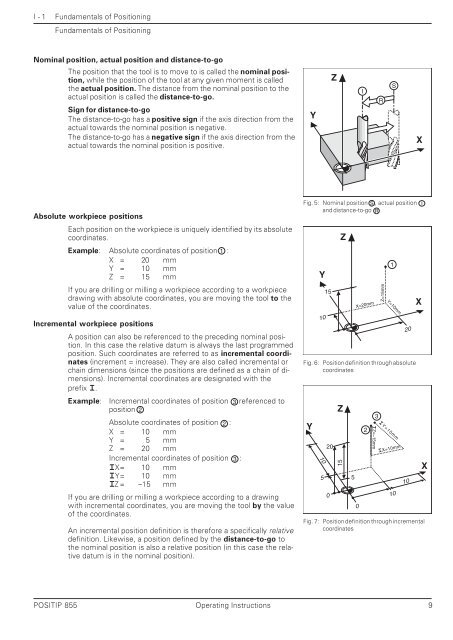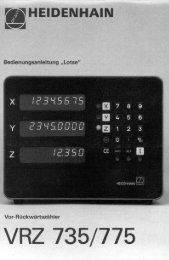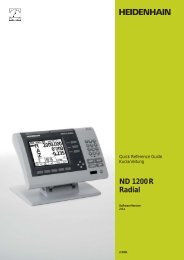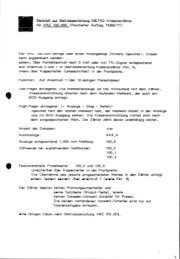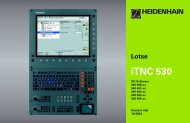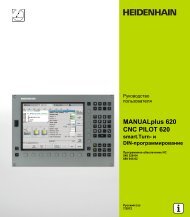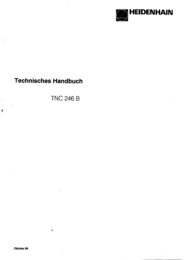POSITIP 855 - heidenhain - DR. JOHANNES HEIDENHAIN GmbH
POSITIP 855 - heidenhain - DR. JOHANNES HEIDENHAIN GmbH
POSITIP 855 - heidenhain - DR. JOHANNES HEIDENHAIN GmbH
Create successful ePaper yourself
Turn your PDF publications into a flip-book with our unique Google optimized e-Paper software.
I - 1 Fundamentals of Positioning<br />
Fundamentals of Positioning<br />
Nominal position, actual position and distance-to-go<br />
The position that the tool is to move to is called the nominal position,<br />
while the position of the tool at any given moment is called<br />
the actual position. The distance from the nominal position to the<br />
actual position is called the distance-to-go.<br />
Sign for distance-to-go<br />
The distance-to-go has a positive sign if the axis direction from the<br />
actual towards the nominal position is negative.<br />
The distance-to-go has a negative sign if the axis direction from the<br />
actual towards the nominal position is positive.<br />
Absolute workpiece positions<br />
Each position on the workpiece is uniquely identified by its absolute<br />
coordinates.<br />
Example: Absolute coordinates of position 1 :<br />
X = 20 mm<br />
Y = 10 mm<br />
Z = 15 mm<br />
If you are drilling or milling a workpiece according to a workpiece<br />
drawing with absolute coordinates, you are moving the tool to the<br />
value of the coordinates.<br />
Incremental workpiece positions<br />
A position can also be referenced to the preceding nominal position.<br />
In this case the relative datum is always the last programmed<br />
position. Such coordinates are referred to as incremental coordinates<br />
(increment = increase). They are also called incremental or<br />
chain dimensions (since the positions are defined as a chain of dimensions).<br />
Incremental coordinates are designated with the<br />
prefix I.<br />
Example: Incremental coordinates of position 3 referenced to<br />
position 2<br />
Absolute coordinates of position 2 :<br />
X = 10 mm<br />
Y = 5 mm<br />
Z = 20 mm<br />
Incremental coordinates of position 3 :<br />
IX= 10 mm<br />
IY= 10 mm<br />
IZ= –15 mm<br />
If you are drilling or milling a workpiece according to a drawing<br />
with incremental coordinates, you are moving the tool by the value<br />
of the coordinates.<br />
An incremental position definition is therefore a specifically relative<br />
definition. Likewise, a position defined by the distance-to-go to<br />
the nominal position is also a relative position (in this case the relative<br />
datum is in the nominal position).<br />
Fig. 6: Position definition through absolute<br />
coordinates<br />
<strong>POSITIP</strong> <strong>855</strong> Operating Instructions 9<br />
Y<br />
Y<br />
10 Z=15mm<br />
Y<br />
10<br />
5<br />
15<br />
20<br />
0<br />
Z<br />
Z<br />
Z<br />
15<br />
5<br />
I<br />
Fig. 5: Nominal position S , actual position I<br />
and distance-to-go R<br />
R<br />
S<br />
1<br />
X=20mm Y=10mm<br />
0<br />
2<br />
3<br />
IZ=–15mm<br />
IY=10mm<br />
IX=10mm<br />
10<br />
20<br />
10<br />
Fig. 7: Position definition through incremental<br />
coordinates<br />
X<br />
X<br />
X


